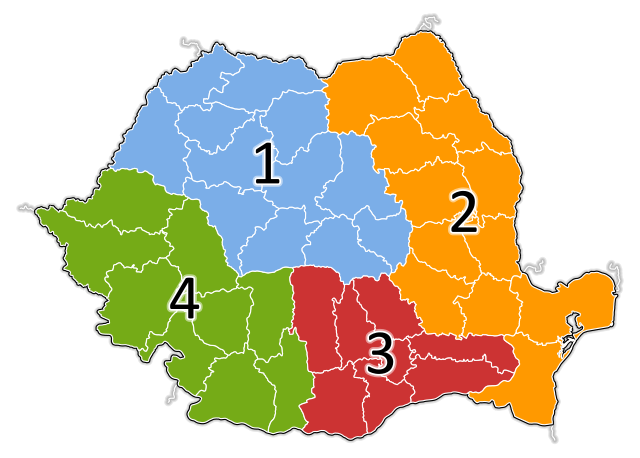Top Qs
Timeline
Chat
Perspective
Development regions of Romania
Overview article From Wikipedia, the free encyclopedia
Remove ads
The development regions of Romania (Romanian: Regiunile de dezvoltare ale României) refer to the eight regional divisions created in Romania in 1998 in order to better co-ordinate regional development as Romania progressed towards accession to the European Union (EU). The development regions correspond to NUTS 2-level divisions in EU member states. Despite becoming increasingly significant in regional development projects, Romania's development regions do not actually have an administrative status and do not have a legislative or executive council or government. Rather, they serve a function for allocating EU PHARE funds for regional development, as well as for collection of regional statistics. They also co-ordinate a range of regional development projects and became members of the Committee of the Regions when Romania joined the EU on January 1, 2007.


Remove ads
List
Summarize
Perspective
There are eight development regions in Romania, which (with the exception of București-Ilfov) are named by their geographical position in the country:
- RO1 – Macroregiunea Unu:
- RO2 – Macroregiunea Doi:
- RO3 – Macroregiunea Trei:
- Sud - Muntenia – RO31; 7 counties; 2,864,337 inhabitants; 34,489 km2 (13,316 sq mi)
- București - Ilfov – RO32; 1 county and Bucharest; 2,259,669 inhabitants; 1,811 km2 (699 sq mi)
- RO4 – Macroregiunea Patru:
- Sud-Vest Oltenia – RO41; 5 counties; 1,873,606 inhabitants; 29,212 km2 (11,279 sq mi)
- Vest – RO42; 4 counties; 1,668,921 inhabitants; 32,028 km2 (12,366 sq mi)
Remove ads
Economy
Remove ads
HDI index

Legend:
≥ 0.900
0.840 – 0.900
0.820 – 0.839
0.800 - 0.819
List of NUTS2 statistical regions of Romania by Human Development Index as of 2023[10]
See also
References
Wikiwand - on
Seamless Wikipedia browsing. On steroids.
Remove ads
